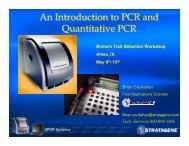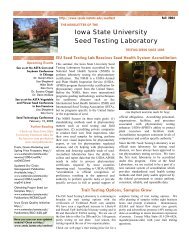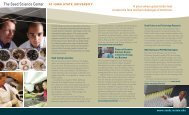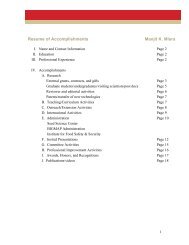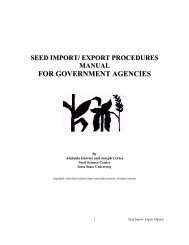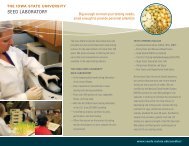Confined Production Processes for Non-Food Corn - Seed Science ...
Confined Production Processes for Non-Food Corn - Seed Science ...
Confined Production Processes for Non-Food Corn - Seed Science ...
Create successful ePaper yourself
Turn your PDF publications into a flip-book with our unique Google optimized e-Paper software.
Assuming production of PMPs or PMIs on inbred femaleplants, each 100 ha of commercial production femalewould require approximately 1 ha of foundation production.The standards <strong>for</strong> foundation production may be differentbecause of the need <strong>for</strong> it to remain open pollinated.FIGURE 8. PRODUCTION OF CYTOPLASMIC STERILE FEMALESCYTOPLASMIC MALESTERILE, FIELD 1MAINTAINER 2FIELD 2<strong>Production</strong> can be on either inbred or hybrid female parents.<strong>Production</strong> on inbred females with the PMP event simplifiesfoundation production and limits the number of foundationisolations with open-pollinating PMP males, but it alsoincreases the area that would be required to produce agiven amount of PMP product by 30 to 50%.Sterile1XMaintainer1Maintainer2Use of hybrid females heterozygous <strong>for</strong> the event is unlikely.If a female plant is heterozygous <strong>for</strong> the PMP event andthe male does not carry the gene, only 50% of the kernelswill carry the PMP event. Use of a heterozygous hybridwith a nontrait male would reduce the concentration ofthe product in the grain.From the standpoint of the breeding required, the procedurallysimple way to obtain a homozygous female is to use aninbred. There are at least three more complex schemesthat might be used:1. Fertile hybrid females where both lines carry the event.2. Cytoplasmic male sterile inbred females.3. Cytoplasmic male sterile hybrid females.Sterile1Sterile1XSterile Hybrid <strong>Production</strong>,Field 3XMaintainer1Maintainer2Maintainer2Cytoplasmic male sterile inbred females involveproducing seed of two almost identical lines. The sterileline produces no pollen. The maintainer line producespollen that fertilizes the sterile line and itself. Cytoplasmicmale sterile hybrid females involve production of thesame sterile-maintainer pair plus one other line that isa maintainer of sterility and fertile. When the secondmaintainer is crossed by the first sterile, the result isseed that produces male sterile hybrid plants.Figure 8 is a diagrammatic representation of the two<strong>for</strong>ms of cytoplasmic sterile production. It demonstratesthat use of cytoplasmic male sterile hybrids would requiretwo kinds of foundation isolations where pollen-sheddingmales would be used. Additional pollen control in thehybrid production field requires more line developmentand pollen exposure in foundation production.SterileHybridWe have used a single flowchart to describe large,open-pollinated trials, foundation production, andcommercial PMP or PMI production. The proceduresinvolved are very similar. In open-pollinated field trialsand production involving open-pollinating male fertilePMP or PMI plants, location and isolation policy aredifferent from production by using male sterile ordetasseled trait plants. For PMP or PMI productswhere the degree of hazard is above some threshold,policy makers may choose to exclude open-pollinatedproduction from areas where large amounts of cornproduction, foundation seed production, or cornresearch is conducted.Larger Scale <strong>Production</strong> 51



